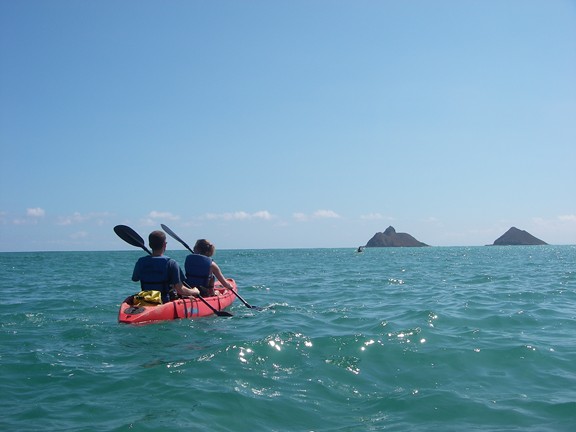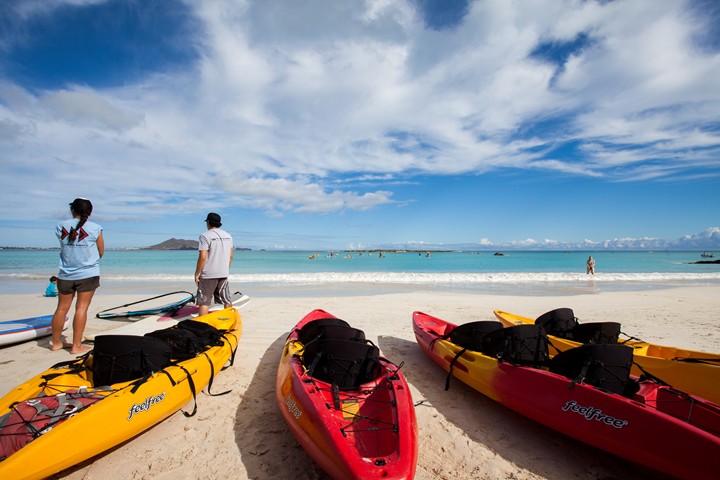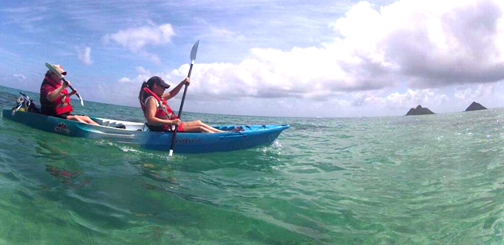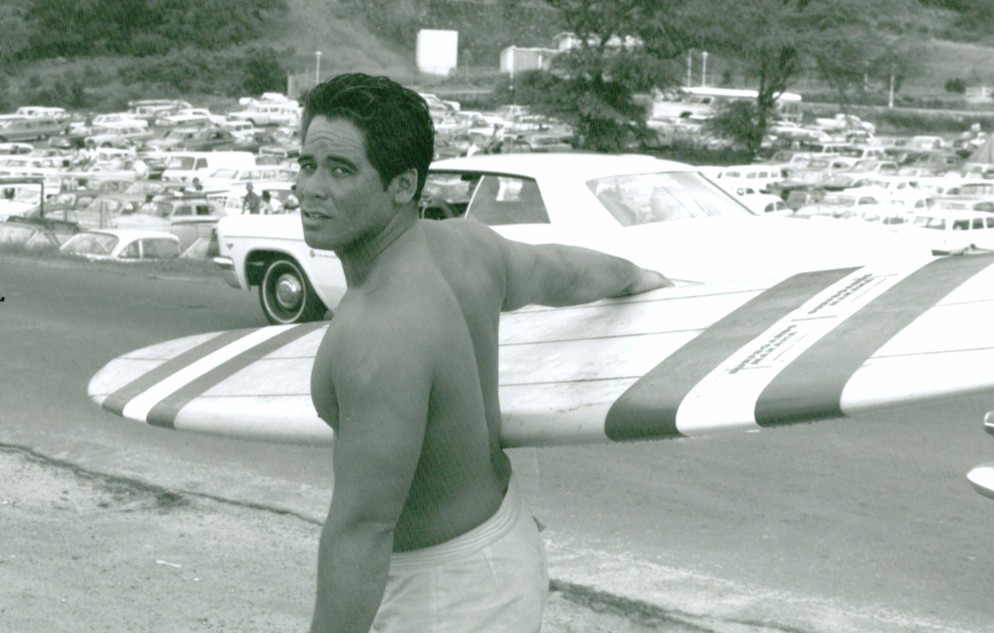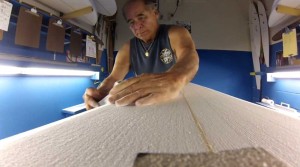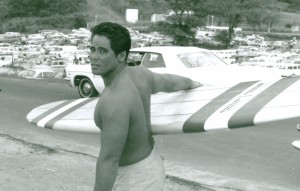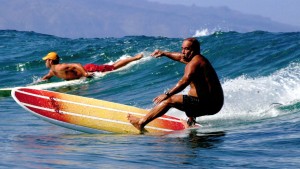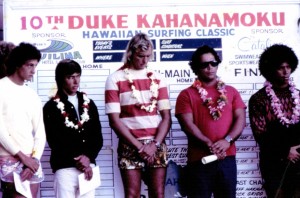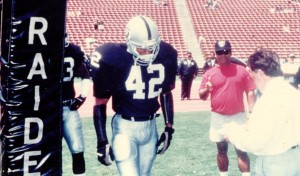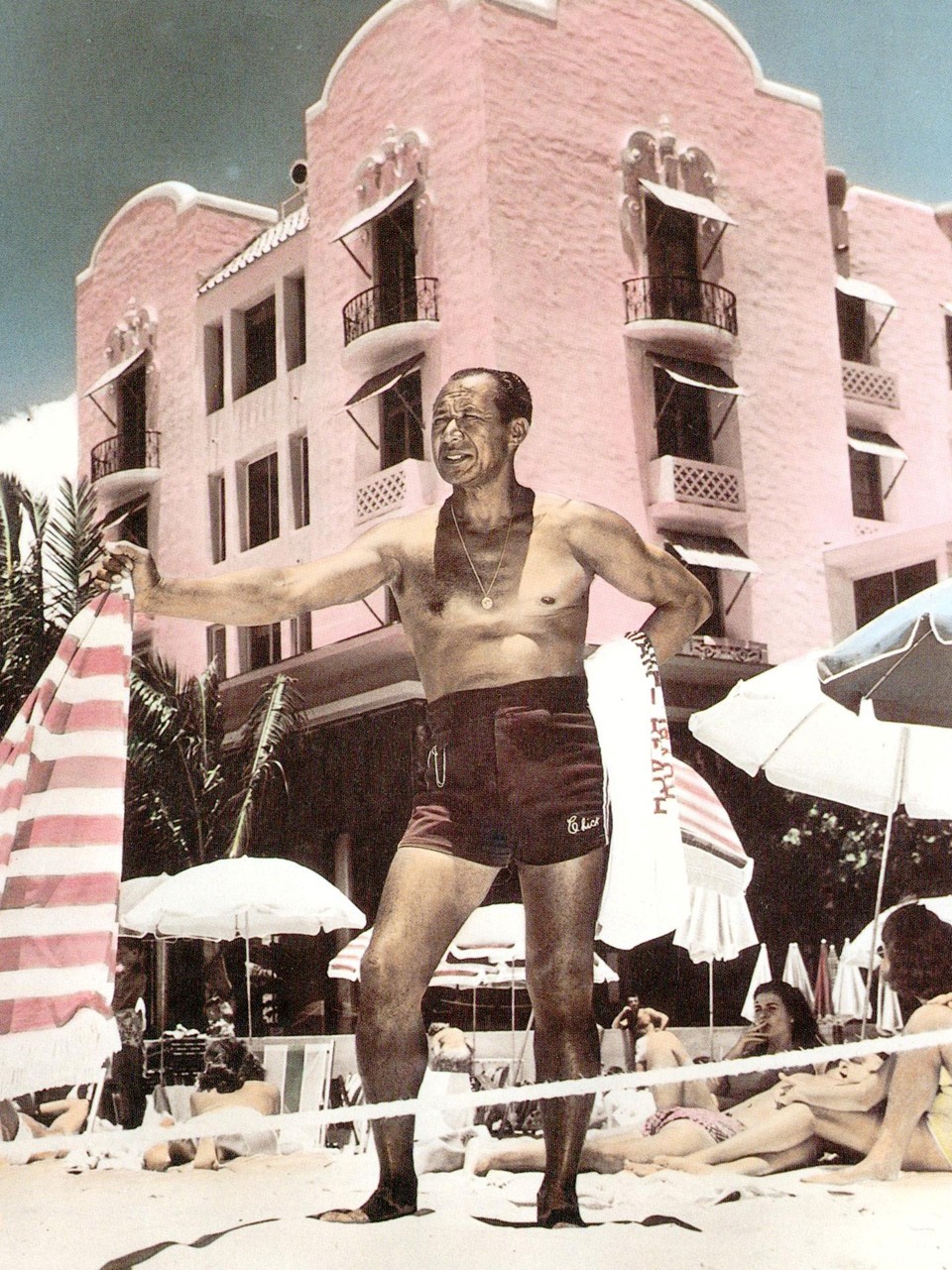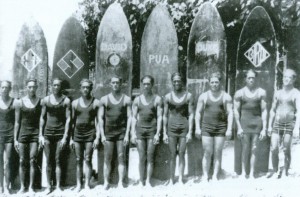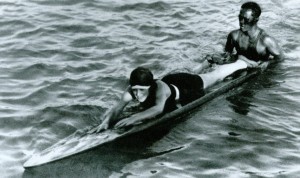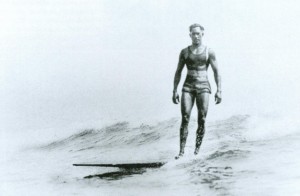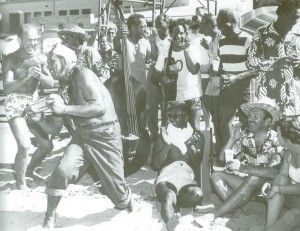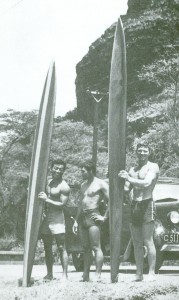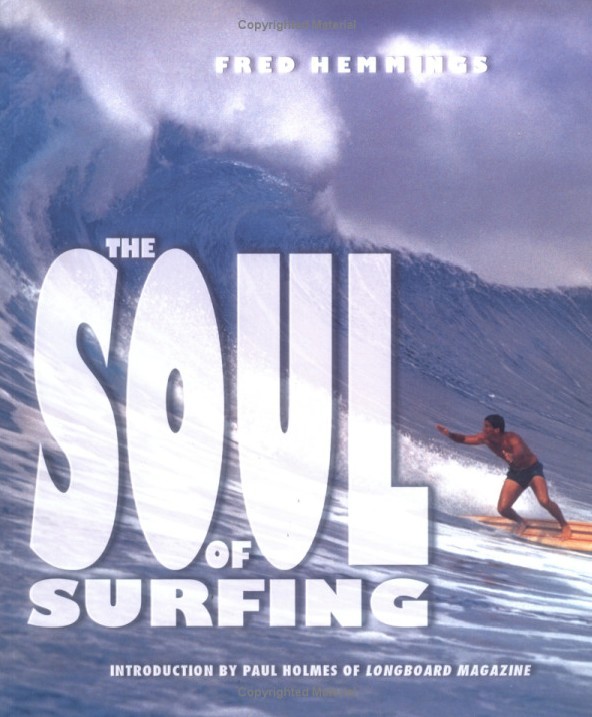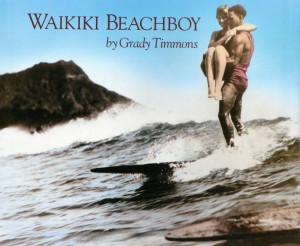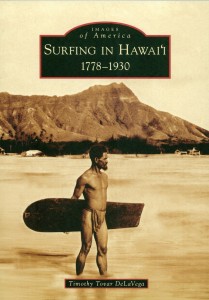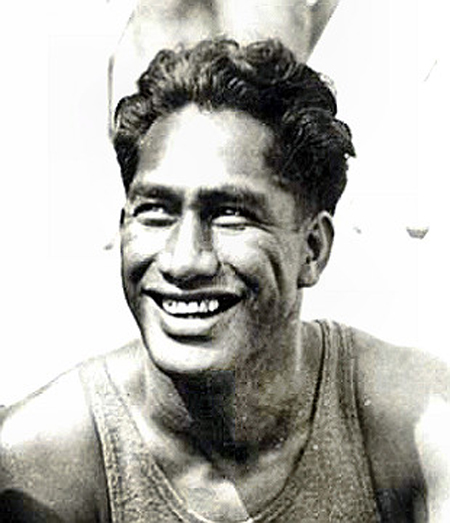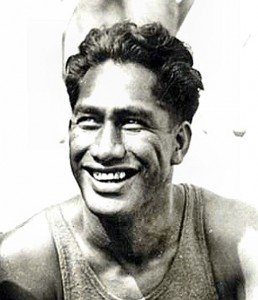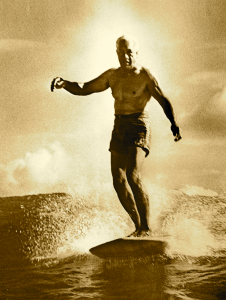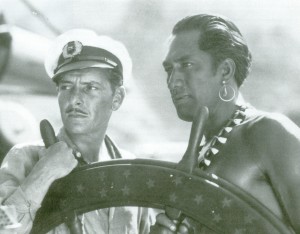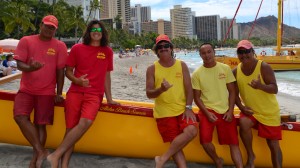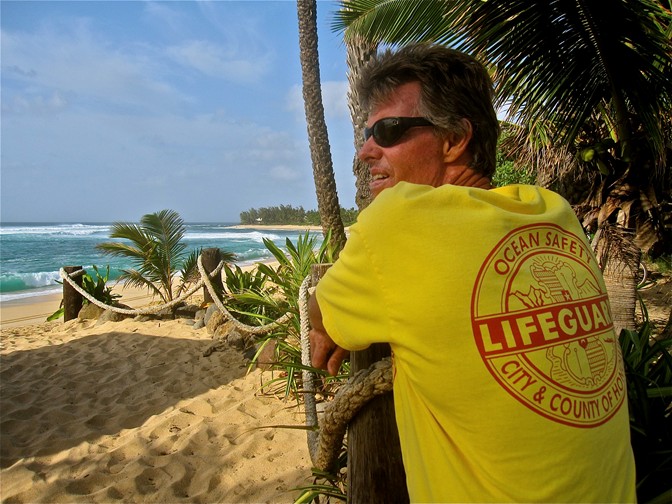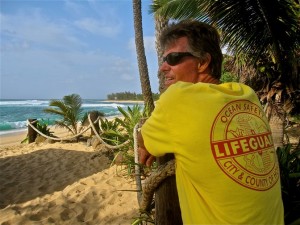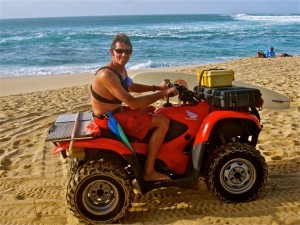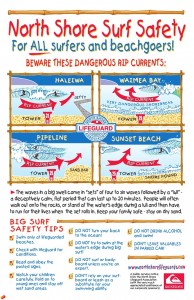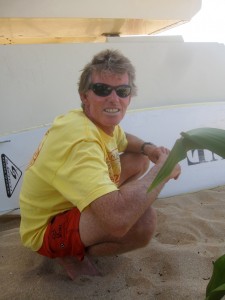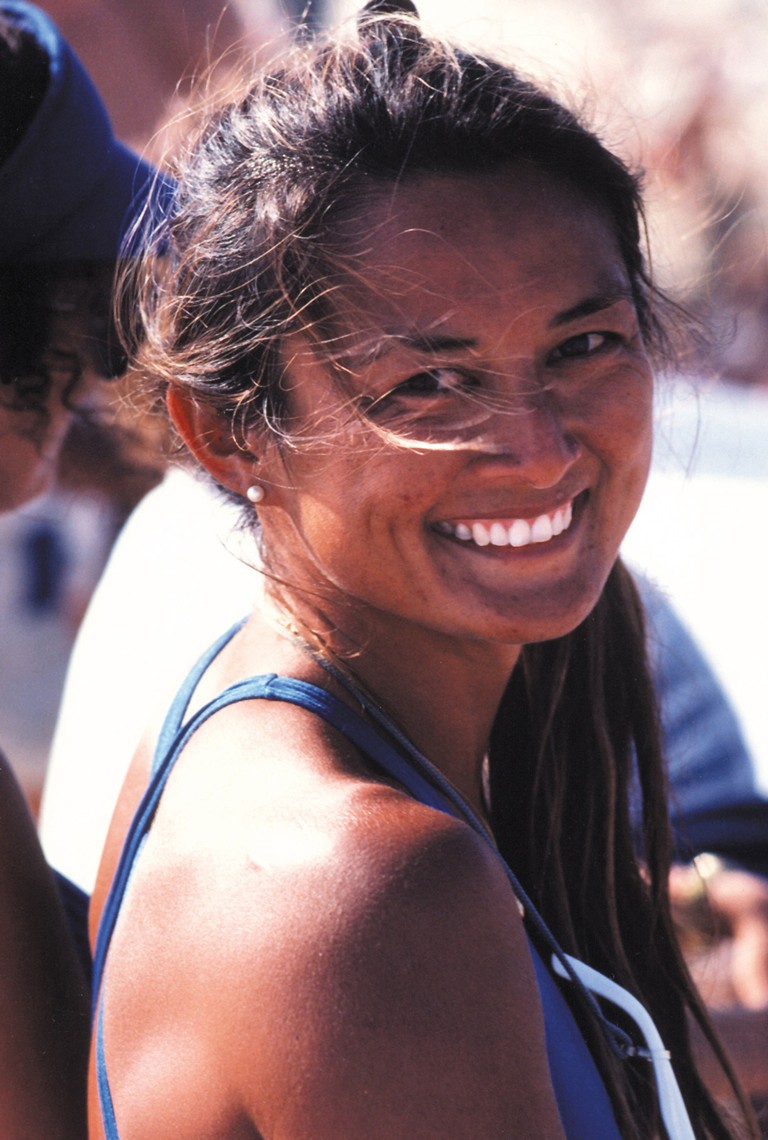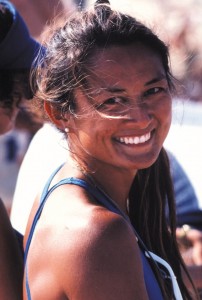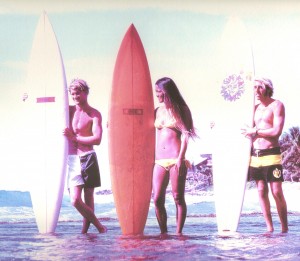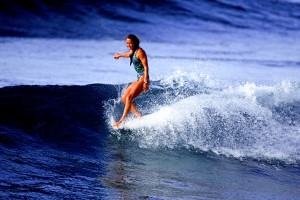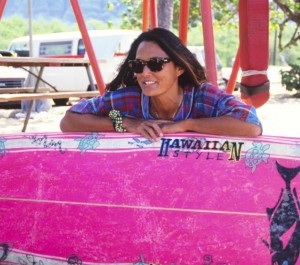By Rex Dubiel –
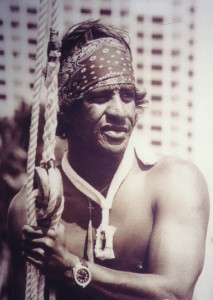
(unknown photographer)
Edward Ryon Makuahanai Aikau was born on May 4, 1946, in Kahalui, Maui. The third of six siblings, Eddie grew up close to his brothers and sisters. When he was eleven years old, he took up board riding and learned to surf in the shore break at Kahalui Harbor. In 1959 the Aikau family moved to Oahu. Eddie dropped out of high school at 16 and began working at the Dole Pineapple Cannery to help support the family. He was able to surf on his breaks and schedule his job around his passion. He bought his first brand new surfboard with his paycheck from Dole—a Dale Velzy.

(photo by Jeff Divine)
Because of Eddie’s ability as a skilled waterman and good swimmer, and because he was at home when surfing big waves, he was hired by the City and County as the first lifeguard on the North Shore. Although he did not have a high school diploma, the City made an exception for this extraordinary surfer and put him in the tower at Waimea Bay. Eddie made daring rescues in raging surf and saved many lives. (There was never a loss of life while Eddie was on duty.) One of the benefits of being a lifeguard is being able to go out in the ocean during breaks and lunch, so Eddie continued to surf when the waves permitted. He became more skillful and daring, always challenging the moving mountains of water, and winning. Taking off on 30-foot waves, Eddie screamed down the faces with a big smile looking as fearless as could be. His prowess enabled him to win the Duke Kahanamoku International Surfing Championship in 1977. He was honored by his fellow lifeguards in 1971 and named “Lifeguard of the Year”. Eddie was loved by those who knew him. As Barry Kaniapuni, another big wave rider and surfboard shaper stated, “Eddie was a throw back with the old ‘Hawaiian kine’ attitude.” He was the kind of fellow who would give you the shirt off his back, just a regular, down-to-earth guy.” At 31, Eddie Aikau was on top of the world!
In 1978, the Polynesian Voyaging Society was looking for volunteers for a 30-day, 2,500-mile journey following the ancient Polynesian route of the migration between the Hawaiian and Tahitian island chains. Eddie was excited and wanted to be part of history and his Hawaiian ancestry. He was proud of his heritage. He was a descendent of Kahuna Nui Hewahewa, the highest Hawaiian priest in the 19th century. Hewahewa became the caretaker of Waimea Valley where, 100 years later, Eddie would guard the beach. This young lifeguard was thrilled with the prospect of being a crewmember of the voyage. He even composed a song for the double-hulled canoe named the Hokule’a, Hawaiian for North Star. Eddie prevailed and was chosen to make the round-trip journey (The second for the Hokule’a).
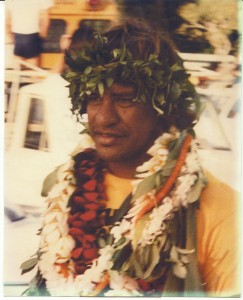
(photo by David Bettencourt)
On a windy afternoon on March 16, 1978, the Governor, press, and thousands of well-wishers and family were at the Magic Island in Waikiki for the send off. The conditions weren’t ideal, but with all the fanfare and the pressure to cast off, the crew reluctantly departed and headed south. The weather worsened with waves slamming against the canoe creating a leak in one of the hulls. Eventually deep in the Molokai Channel, 12 miles off the coast of Lanai, the Hokule’a capsized. There were no escort boats to notify officials of trouble, the emergency radio and emergency beacon were washed overboard. Now, the course of the Hokulea was being set by the stars. The crew clung to the canoe for eight hours in the dark before Eddie bravely volunteered to paddle his surfboard to Lanai for help. After much debate, Eddie shoved off with a few oranges strung around his neck, his surfboard leash tied to his ankle, and a life vest strapped to his chest. Within a few hundred yards of the overturned boat, Eddie shed the vest to paddle unencumbered. His daring silhouette got smaller and smaller as he rose to his knees and paddled towards the lights of Lanai, braving the choppy surf and gale force winds.
That was the last time Eddie Aikau was ever seen. Several hours later, as the sun came up, a small plane spotted the Hokule’a and her stranded crew. Within minutes, a Coast Guard vessel was dispatched and the exhausted survivors were rescued. The largest air-sea search in modern Hawaiian history failed to find Eddie. “He gave his life to save others,” stated his grief-stricken younger brother, Clyde Aikau. It was a sad day in Hawaiian history when this 31-year old big wave rider, lifeguard, and Polynesian voyager was lost at sea.
“Eddie Would Go” has become a very popular saying attributed to Eddie Aikau. It’s on bumper stickers and t-shirts all over the world. The phrase originated at the first Quiksilver Big Wave Invitational contest when Mark Foo, another big wave rider and competitor, overheard the judges debating whether to hold the contest because the waves were so big and dangerous. Knowing Eddie’s love of riding massive surf and charging into the waves to make rescues, Mark interjected, “Eddie would go”. The judges agreed, the contest was on, and the phrase stuck.
Stuart Coleman, author, teacher and local coordinator for Surfrider Foundation Oahu Chapter, just released his 10th anniversary edition book about Eddie Aikau’s life, Eddie Would Go. During his research Stuart came to know Eddie as, “Genuinely selfless and, although painfully shy, would step into positions of leadership to resolve issues between surfers with conflicts on the North Shore. Eddie was also a talented musician and slack key guitarist.”
So, when you are on the North Shore, looking out over Waimea Bay, for winter surf or summer snorkeling, remember Eddie Aikau. Come visit the plaque honoring this Hawaiian legend at the entrance to the beach. Reflect and understand the importance of one man who challenged the sea, who paddled into the dark night to save his fellow voyagers, and to this day inspires others to dare the big waves.
Eddie’s surf contest accomplishments.
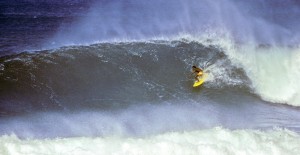
(Photo by Jeff Divine)
1968 Duke Kahanamoku Invitational
Eddie Aikau (3rd place)
1971 Smirnoff Contest, Hawaii
Eddie Aikau (3rd place)
1976 World Cup Contest, Hawaii
Eddie Aikau (3rd place)
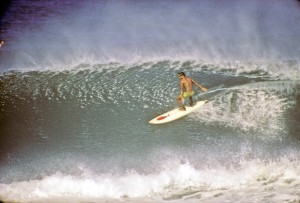
(Photo by Jeff Divine)
1976 Smirnoff Contest, Hawaii
Eddie Aikau (3rd place)
1977 Duke Kahanamoku Invitational
Eddie Aikau (1st place)
Eddie’s legacy lives on…
The Eddie Aikau Foundation
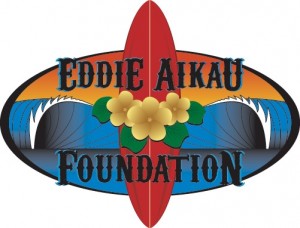 Mission Statement: The Eddie Aikau Foundation is a charitable organization created to share Eddie Aikau’s life, contributions and accomplishments while promoting education and the advancement of Hawaiian culture. Founded by the Aikau Family, the Foundation pays tribute to Edward Ryon Makuahanai Aikau in honor of his love for his family and others, his courage and compassion in saving lives, and his dedication to the Hawaiian People and their culture. Eddie’s legacy is a pure symbol of the Aloha Spirit.
Mission Statement: The Eddie Aikau Foundation is a charitable organization created to share Eddie Aikau’s life, contributions and accomplishments while promoting education and the advancement of Hawaiian culture. Founded by the Aikau Family, the Foundation pays tribute to Edward Ryon Makuahanai Aikau in honor of his love for his family and others, his courage and compassion in saving lives, and his dedication to the Hawaiian People and their culture. Eddie’s legacy is a pure symbol of the Aloha Spirit.
Goals: The Eddie Aikau Foundation’s ambitious goals are realized through advocacy, education and philanthropy. These goals include: advancing education and community service; supporting ocean-related activities and events; assisting in the preservation and perpetuation of Hawaiian history and culture; and encouraging Hawaiians and visitors alike to respect and contribute to the growth and development of Hawaiian culture. Through Eddie’s remarkable spirit and character, the Foundation strives to inspire people to develop a strong sense of pride in themselves, their heritage and their community.
Courage to do the right thing: Eddie Aikau had courage to ride giant waves in Hawaii. He was a man who rode “mountains”. He was also a person who had the ultimate courage to do the right thing. Eddie was a lifeguard. He saved the lives of people of all races, color and creed with no hesitation. To lose one life was something he tried to prevent with all his might. He loved life as a precious gift! One of our goals is to inspire and encourage people of all walks of life to do the right thing when they have the chance.
The Essay Contest
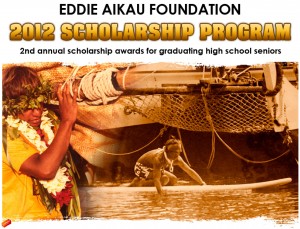 Eddie Aikau Foundation has been conducting an annual Essay Contest since 2006 for all the 7th to 10th grade students in the State of Hawaii, from both public and private schools, including those students in a state monitored home- school program. There are English and Hawaiian Language Divisions so the students can submit their essays in either language for judging. For 2012 essay contest that ended this past March, 627 essays were submitted for judging. The Foundation also has a new Scholarship program for graduating High School Seniors and just awarded $20,000 in scholarships to 15 students, this past June.
Eddie Aikau Foundation has been conducting an annual Essay Contest since 2006 for all the 7th to 10th grade students in the State of Hawaii, from both public and private schools, including those students in a state monitored home- school program. There are English and Hawaiian Language Divisions so the students can submit their essays in either language for judging. For 2012 essay contest that ended this past March, 627 essays were submitted for judging. The Foundation also has a new Scholarship program for graduating High School Seniors and just awarded $20,000 in scholarships to 15 students, this past June.
Eddie Would Go by Stuart Coleman
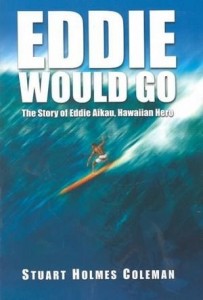 After four years of research, writing and more than 40 interviews with Eddie’s family, friends and fellow watermen, Stuart Coleman published the biography Eddie Would Go, in 2002. The book went on to become a bestseller and it earned the Cades Award for Literature. A paperback edition was published by St. Martin’s Press in 2004, and the biography has since been translated into Japanese, Portuguese and German. This year marks the 10th Anniversary of the book’s publication, and the new edition is available at Barnes & Noble and other bookstores, as well as on Amazon, Kindle and iBooks. For more information, go to www.EddieWouldGo.com or www.Stuart-Coleman.com.
After four years of research, writing and more than 40 interviews with Eddie’s family, friends and fellow watermen, Stuart Coleman published the biography Eddie Would Go, in 2002. The book went on to become a bestseller and it earned the Cades Award for Literature. A paperback edition was published by St. Martin’s Press in 2004, and the biography has since been translated into Japanese, Portuguese and German. This year marks the 10th Anniversary of the book’s publication, and the new edition is available at Barnes & Noble and other bookstores, as well as on Amazon, Kindle and iBooks. For more information, go to www.EddieWouldGo.com or www.Stuart-Coleman.com.
The Quiksilver in Memory of Eddie Aikau
 Quiksilver, an international surf wear and ocean lifestyle company, honors Eddie Aikau by sponsoring, “The Eddie”—the Quiksilver in Memory of Eddie Aikau. This surfing contest, created in 1984 at Sunset Beach and moved to Waimea Bay in 1987, draws big wave riders from around the world to the North Shore. There are also hundreds of spectators. Every year, as large swells make way to Hawaii, everyone wants to know “are they going to have the Eddie?” Any early swell, the largest in 15 years on this date, hit the north and west shores of Oahu with 20’ to 25’ faces in early October 2012, leaving the surf world anticipating and hoping for large swells. Will we see The Eddie this year?
Quiksilver, an international surf wear and ocean lifestyle company, honors Eddie Aikau by sponsoring, “The Eddie”—the Quiksilver in Memory of Eddie Aikau. This surfing contest, created in 1984 at Sunset Beach and moved to Waimea Bay in 1987, draws big wave riders from around the world to the North Shore. There are also hundreds of spectators. Every year, as large swells make way to Hawaii, everyone wants to know “are they going to have the Eddie?” Any early swell, the largest in 15 years on this date, hit the north and west shores of Oahu with 20’ to 25’ faces in early October 2012, leaving the surf world anticipating and hoping for large swells. Will we see The Eddie this year?
Because surfing conditions must be just right, The Eddie has been held only eight times since its inception. Open ocean swells must reach a minimum of 20 feet equaling a wave face of 30 feet in the Bay, with good surfing conditions. The most recent contest was held in December of 2009 when waves were registering 30 to 50 feet. Only 28 surfers are invited to vie for first prize in two rounds of competition. Clyde Aikau, Eddie’s brother, won the first Eddie in 1985 and continues to surf in the contest. Current holding period is December 1, 2012 to February 28, 2013. The opening ceremony is November 29, 2012.
Past Winners:
2009/2010 – Greg Long
2004/2005 – Bruce Irons
2001/2002 – Kelly Slater
2000/2001 – Ross Clarke-Jones
1998/1999 – Noah Johnson
1989/1990 – Keone Downing
1986/1987 – Clyde Aikau
1984/1985 – Denton Miyamura
